Affiliate disclosure: This post may contain affiliate links. Please see our Privacy Policy.
Rosehip wine is a delightful way to use rosehips in season. When made with sugar, it’s a simple country wine with plenty of flavor and rich color. For a real treat, it can also be made with honey as rosehip mead, which gives it more body and a much more complex finish.

Rosehip wine is a refreshing delight for sipping during spring and summer, and is quite simple to make. This wine has a crisp taste, similar to apple wine, and is very palatable.
Making rosehip wine is a refreshing way to use fresh or dried rosehips. This simple country wine carries a subtle flavor and beautiful rich color. When honey is used instead of sugar, it lends the wine more body and a wonderfully complex finish.
All varieties of roses will yield rosehips if the blooms are left untrimmed. These hips contain rose seeds. You’ll see the fruits develop on spent blossoms that have been pollinated in the summer, oftentimes changing to orange in late summer and finally a glorious red hue in the fall.
Whether picking your own or foraging for rosehips, be sure to select those that are bright red and free of pesticides, pollutants, or roadside runoff. If unable to source fresh rosehips, dried ones can usually be located online.
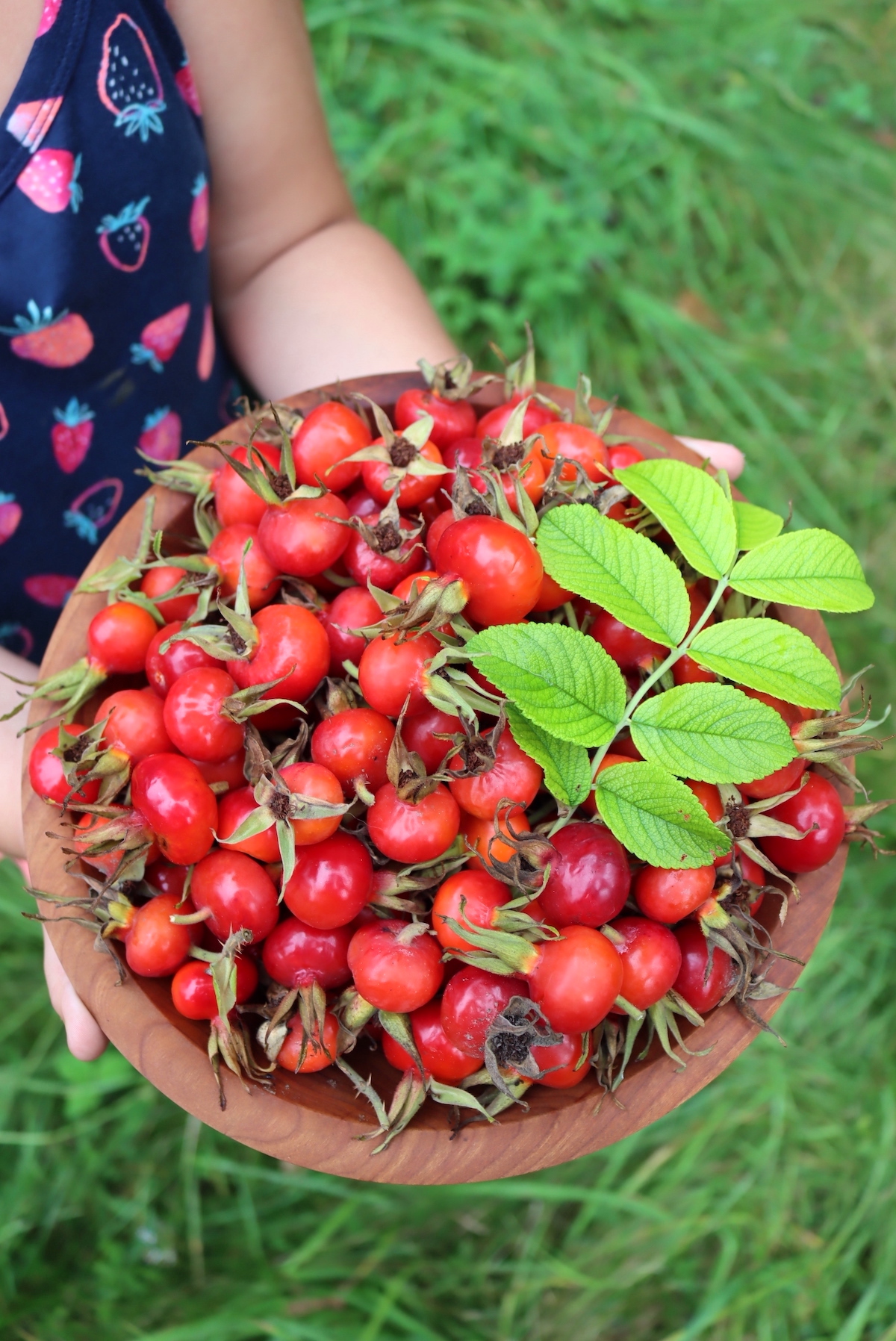
The steps for making rosehip wine are similar to most small-batch country wines.
You’ll chop the fruit, add some sugar for sweetness, toss in a few additional winemaking additives and top it off with a nice strain of winemaking yeast.
This mixture will ferment for 8 to 10 days during which the active fermentation will be bubbling. Then it’s time to siphon the mixture over to a fresh fermentation vessel, leaving the fruit and sediment behind.
Here the mixture ferments more slowly, (hopefully in a cool, dark location) for anywhere from 6 weeks to 6 months. Now, all that’s needed is to bottle the wine and let it bottleage for as long as you can before drinking. Rosehip wine is one of those wines that calls for lengthy bottle aging (up to 2 years) in order for the wine to mature.
Trust me though, it’s worth the wait!
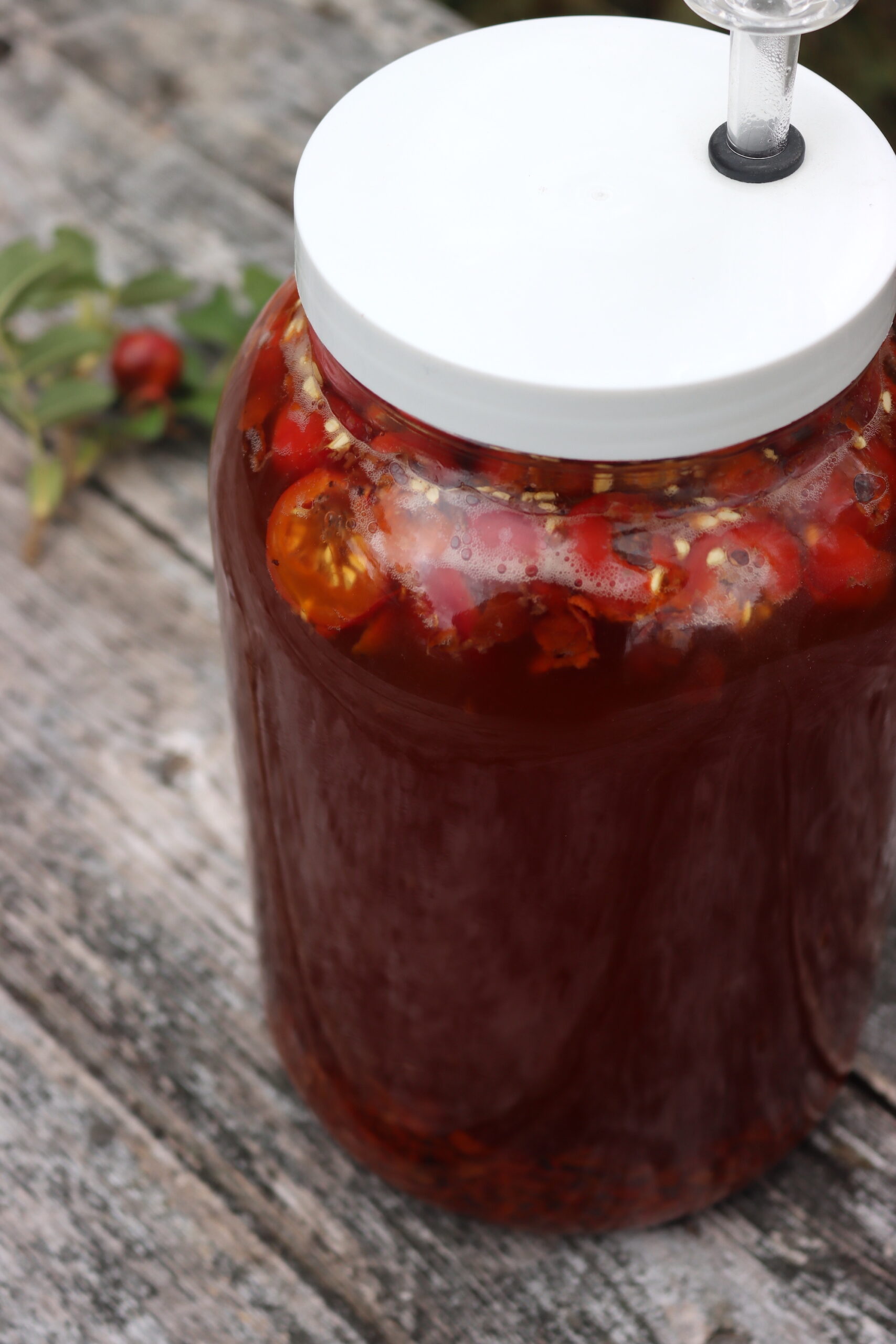
This recipe has been written for those who are already familiar with general winemaking practices and terminology. If you’re newer to the world of home winemaking, these beginner’s guides will be helpful to you:
- Beginners Guide to Making Fruit Wines, where I cover all the necessary steps in the winemaking process.
- How to Make Mead (Honey Wine) is quite similar, but covers some of the particularities when working with honey.
- Equipment for Winemaking will tell you about all the necessary equipment needed for winemaking (besides your ingredients).
- Ingredients for Winemaking explains all the basic ingredients you’ll need (besides yeast).
- Yeast for Winemaking is a helpful read for being sure you pick the right one for your wine. There are dozens upon dozens of strains out there after all!
Ingredients for Rosehip Wine
When making rosehip wine, only a handful of ingredients are required.
For anyone new to winemaking, be sure to look over this primary on winemaking ingredients. It will help you understand the purpose of each of these ingredients and their role in fermenting!
To make a one-gallon batch of rosehip wine, you will need:
- 2 to 3-½ pounds fresh rosehips
- 2 1/2 pounds of finely granulated sugar (or honey for mead)
- Water to fill
- 1 teaspoon Yeast Nutrient
- 1 teaspoon Acid Blend
- ½ teaspoon Pectic Enzyme
- Wine yeast (Montrachet or champagne yeast)
This recipe does not contain tannin powder, as rosehips contain natural tannins. It does, however, need an acid blend and pectic enzyme. You can buy these ingredients individually or purchase a wine kit for a few dollars. Most kits contain a pectic enzyme, acid blend and wine tannin. You can just toss the tannin, or save it for future winemaking pursuits!
In addition to the acid blend and pectic enzyme, you’ll need a wine yeast and a yeast nutrient. Adding a yeast nutrient ensures the wine yeast has everything it needs to flourish. Some choose to add raisins instead of powdered yeast nutrient, but this is less reliable and can add additional flavors to the wine.
As to your wine yeast, Montrachet yeast is a great one for rosehip wine. Any general-purpose wine yeast will do as well, but steer clear of bread yeast. Bread yeast is not intended for winemaking or extended ferments (and it will also add off-flavors to wines).
Both white wine yeasts and champagne yeast are suited to rosehip wine — VR21 and Lalvin EC-1118 are some nice choices if you’re unsure which to choose.
In addition to these basic winemaking ingredients, you’ll need 2 to 3-½ pounds of fresh rosehips and 2 pounds of finely granulated sugar. As 1 pound of sugar equals about 2 cups, you’ll need about 4 cups of sugar.
Winemaking Equipment
Besides these wine ingredients, you will need the necessary equipment as well:
- One Gallon Glass Carboy (usually sold as a kit with a rubber stopper and water lock together)
- Rubber Stopper and Water Lock (if not included in the kit above)
- Brewing Siphon
- Wine bottles or Flip-top Grolsch bottles
- Bottle Corker and clean, new corks for bottling your wine
- Brewing Sanitizer
When I make fruit wines and include the fruit in the primary fermentation, I prefer using a wide-mouth one-gallon carboy instead of the traditional narrow-neck one. The narrow neck can easily get blocked with fruit pulp, so the wider opening is much more practical. Starting the fermentation with a water lock is important in my home, especially with kids and cats who tend to get into everything. While it’s possible to start fermenting in a large bowl or brewing bucket—since a water lock isn’t strictly necessary until secondary fermentation—keeping things simple, covered loosely to protect from dust, works fine for primary fermentation.
For me, the wide-mouth gallon carboy is the most efficient choice, keeping the process clean and hassle-free.
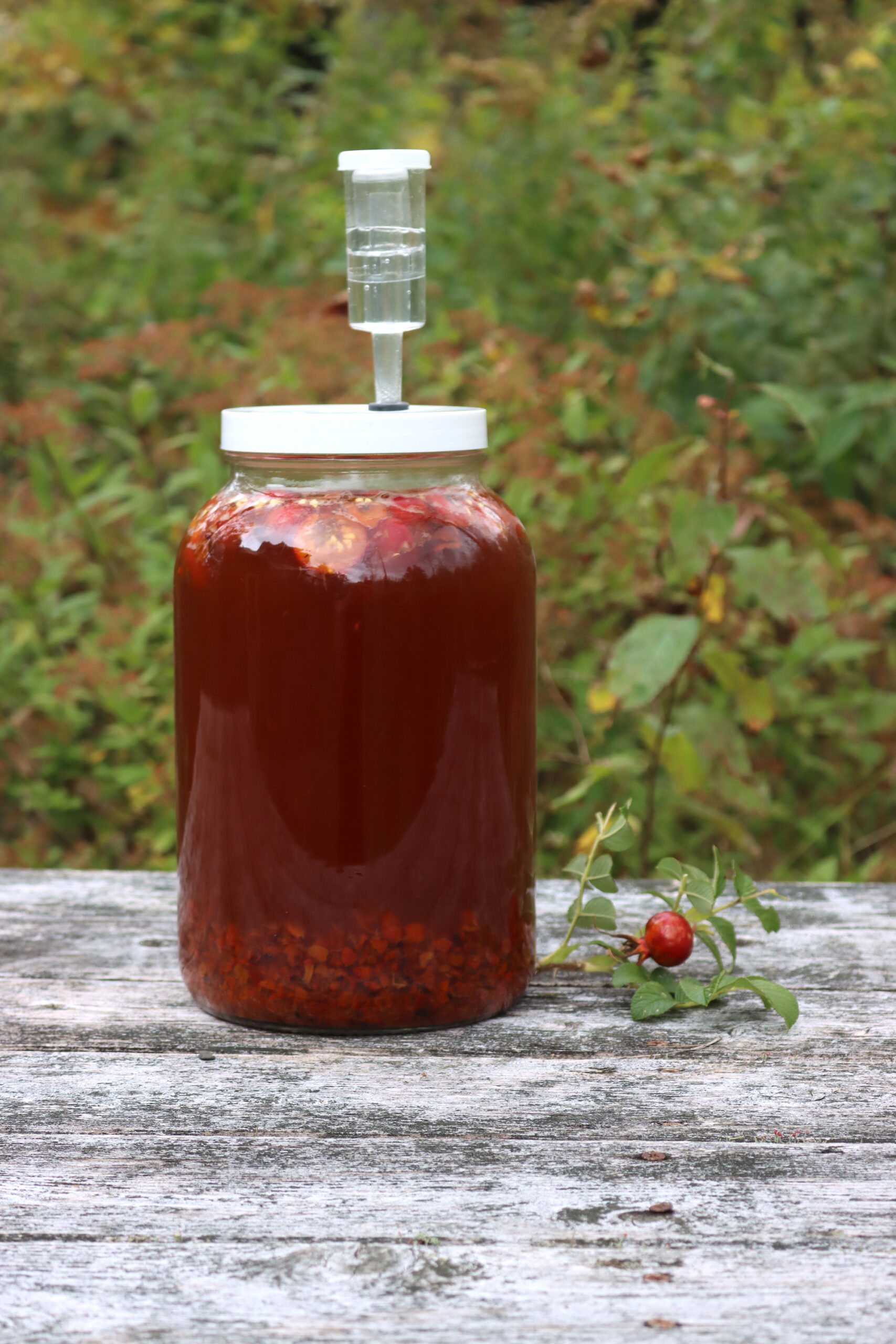
Making Rosehip Wine
Begin by trimming the stems and ends off of your rosehips. Next, take rosehips and coarsely chop them. If desired, place chopped rosehips in a nylon straining bag or other brew bag and tie closed (brew bags are optional but do help with cleanup).
I usually use a wide-mouth one-gallon carboy (shown in the pictures below) instead of a nylon brewing bag in a bucket, but use what you have.
Place the rosehips in a wide-mouth carboy along with the sugar and cover with boiling water. Stir to help the sugar dissolve. (You can also dissolve your sugar by stirring it into the boiling water before boiling.)
Once cool, add the acid blend, pectic enzyme, and yeast nutrient. You will add the wine yeast last.
If using dry yeast, rehydrate it in a small amount of water for 10 minutes to allow the yeast to “bloom.” Add the yeast to the wine mixture and top up with enough water to leave 2 to 3 inches of headspace at the top of your carboy.
Finally, seal the container with a waterlock (this one-way valve will allow CO2 to exit your carboy, but won’t allow any contaminants in).
After a day or so, you should begin to see a very active primary fermentation bubbling away.
Let your rosehip wine ferment in primary for 8 to 10 days. After this, you should begin to see the fermentation slow at this time, with most of the visible bubbling having halted.
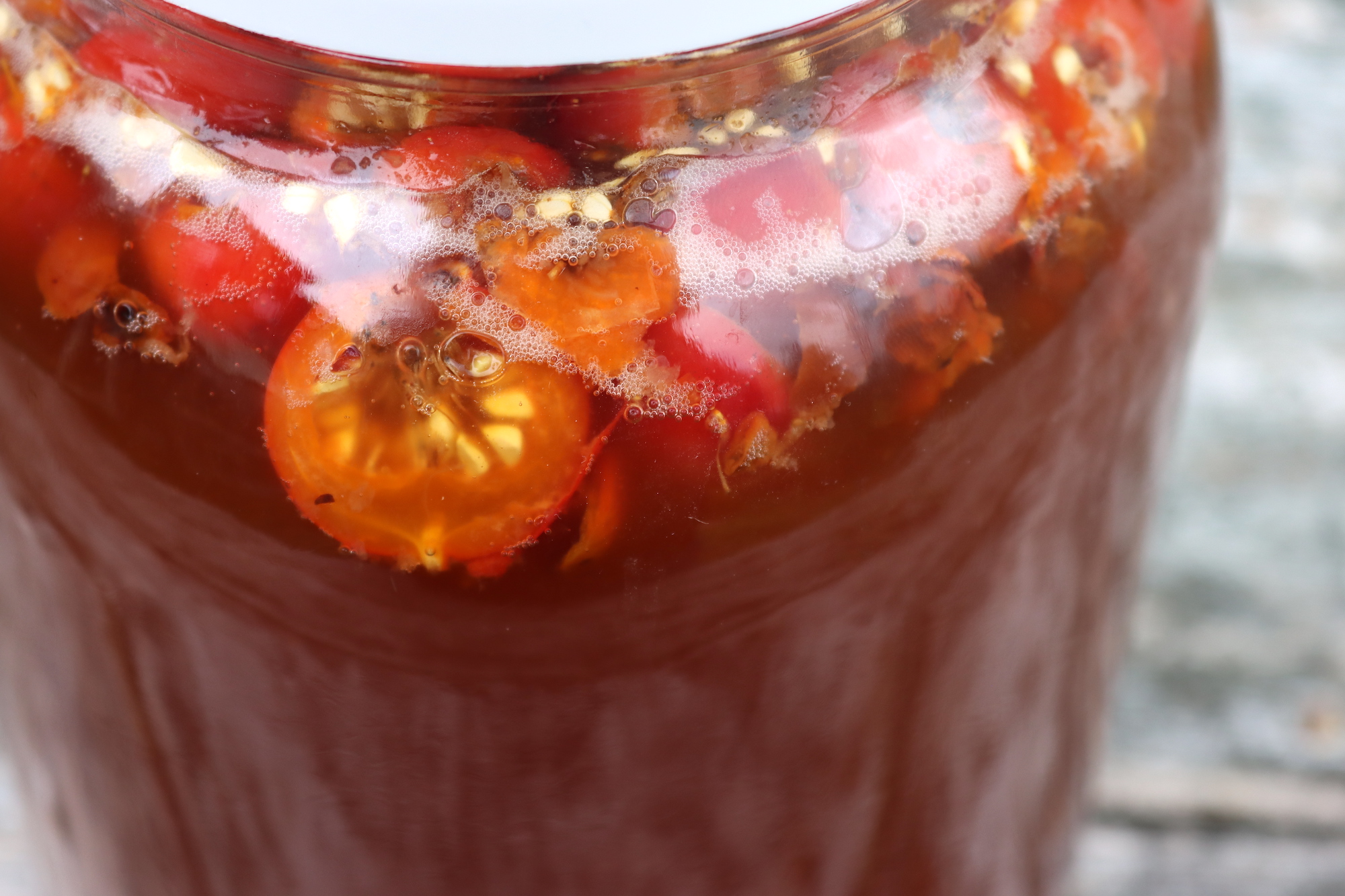
Remove the nylon bag at this point, squeezing it to extract the last of the juice. Siphon the wine to a clean vessel for the secondary ferment, leaving the sediment behind.
Once the wine has been moved to a clean carboy, top your vessel with more water to bring the water level up to the neck of the carboy — this will help expose the least amount of wine to air.
Seal your carboy with a waterlock and let the wine ferment in secondary for another 6 weeks before racking to a clean fermentation vessel to clear the sediment. Let ferment 3 more months.
You will likely need to rack your wine again during secondary to dispose of built-up sediment, top up with more water, and refit the airlock, leaving the wine for another 3 months. When the wine begins to clear, you can bottle it.
If making mead, 2 to 6 months is the necessary time needed during secondary fermentation. This is because honey takes longer to ferment as it’s less digestible than regular old sugar for the yeast.
Before bottling, however, you should sample the wine. It will still be rough at this point but should give you a general idea of the flavor. If the wine is not sweet enough at this time, you can backsweeten it and put it back into ferment for another month.
When backsweetening, be sure to add a Campden tablet (sodium metabisulphite) and a ½ teaspoon potassium sorbate to stop fermentation before adding any sugar. If you skip this step, fermentation may reactivate, and when you eventually bottle your wine in another week or two, the bottles can burst from the pressure.
Allow 24 to 48 hours to pass after adding your Campden and potassium sorbate before adding your sugar to ensure your wine is fully stabilized.
Backsweeten to your taste by creating a simple syrup from equal parts water and sugar and put the wine back into ferment for at least 1 to 2 weeks before bottling.
Once siphoned into bottles, you will need to let the wine bottle age for a good deal of time for rosehip wine to mature. Let the wine bottle age for 18 to 24 months in a cool and dark place.
Ways to Preserve Rosehips
Searching for more ways to use or preserve rosehips?
- 30+ Rose Hip Recipes
- Rose Hip Tea with Fresh or Dried Rose Hips
- Wild Rose Hip Syrup
- How to Make Rosehip Jam
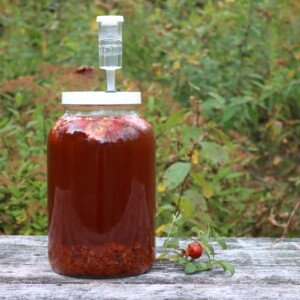
Rosehip Wine
Equipment
Ingredients
- 2 to 3-½ lbs fresh rosehips, or 1/2 to 1 lb dried
- 2 1/2 lbs cane sugar, or honey for mead
- 1 tsp yeast nutrient
- 1 tsp acid blend
- 1/2 tsp Pectic Enzyme
- wine yeast, see note
- Optional ~ Campden Tablet and Potassium Sorbate for stabilizing, only needed for backsweetening
Instructions
- First, wash rosehips to remove any lingering bugs or insects. Next, trim the stems and ends off.
- Coarsely chop rosehips. If desired, place in a brew bag and tie closed.
- Place the rosehips in a wide-mouth carboy and top with sugar.
- Boil water and pour into the carboy. Stir until sugar dissolves.
- Once cool, add the acid blend, pectic enzyme, and yeast nutrient.
- Add the wine yeast last. (If the yeast requires rehydrating, be sure to do this 10 minutes before adding to your wine.)
- Finish filling the carboy with enough water to bring it to leave about 2 inches of headspace.
- Seal with the waterlock and let the mixture ferment in primary for 8 to 10 days.
- Remove the bag from the wine and give it a good squeeze to remove the last of the juice. Discard the bag and siphon your wine to a new carboy for secondary ferment, leaving the sediment behind.
- Allow to ferment in secondary for 6 weeks before racking to a clean fermentation vessel and fermenting for another 3 months. After this, you may need to rack the wine again to discard sediment and continue to ferment until the wine is clear.
- Once the wine clears, it is ready for bottling. Taste the wine before bottling and adjust as needed. If backsweetening, put back into ferment for 2 weeks to 1 month.
- Bottle your wine with corks. Allow to bottleage for 18 to 24 months before drinking.
Notes
Amount of Fruit
You can use anywhere from 2 lbs to 3-½ pounds of fruit for this recipe. Dried rose hips can be used as well, but they should be crushed and soaked in water overnight to rehydrate first. About half a pound of dried rosehips should be enough for 1 gallon of rosehip wine.Yeast
For rosehip wine, select a wine yeast with a moderate alcohol tolerance. It should ferment clean or add light fruit characteristics. Montrachet wine yeast or champagne yeast will work well with rosehip wine. About ⅕ of a packet will be needed for a single gallon supply of wine.Stabilizing and Back Sweetening
After checking your wine at the end of secondary, you may find it too dry for your taste. In this case, backsweetening is an option. To backsweeten, move the wine to a clean fermentation vessel and add 1 Campden tablet and ½ teaspoon potassium sorbate to stabilize the wine and kill the yeast. If you do not stabilize your wine before adding sugar, it can ferment rapidly in the bottles and they may burst. Once stabilized, add sugar to taste (I suggest adding about a ½ cup of sugar at a time for a one-gallon batch of rosehip wine). To add sugar, make a simple syrup by dissolving 1 part sugar and 1 part water in a saucepan. Add this to your wine and put back into ferment for at least 1 to 2 weeks before finally bottling.Nutrition
Nutrition information is automatically calculated, so should only be used as an approximation.
Autumn Winemaking Recipes
Looking for more winemaking recipes? I have one for just about every fruit under the sun (some veggies and flowers too).
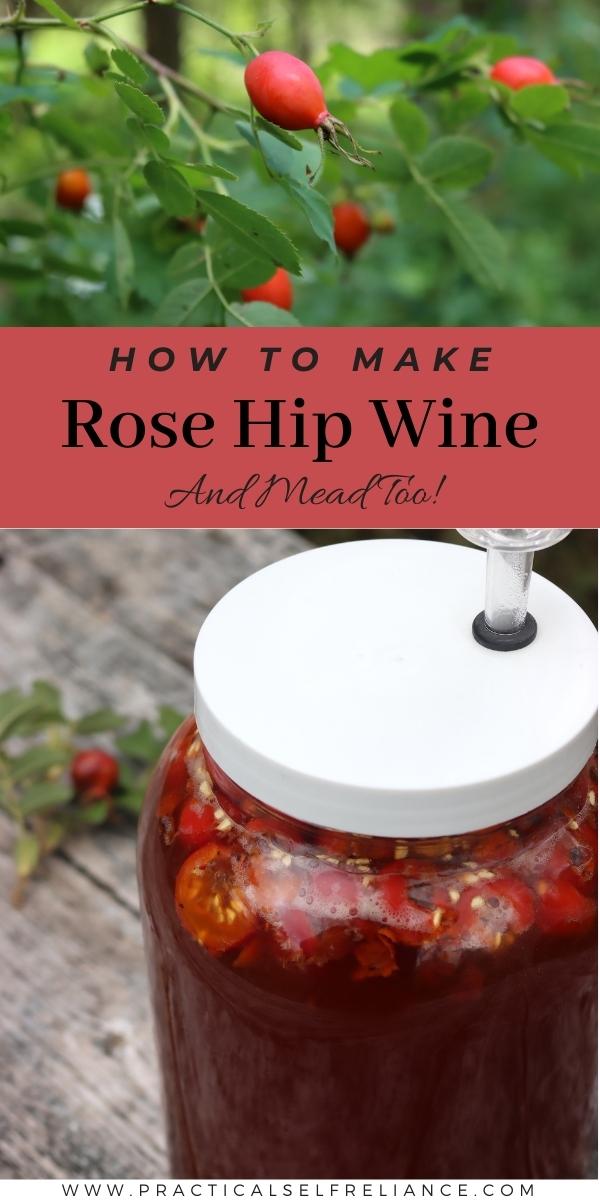



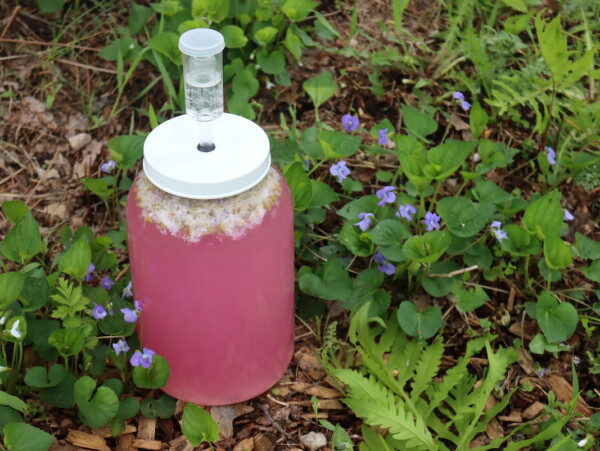










Absolutely delicious!